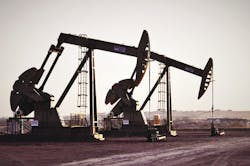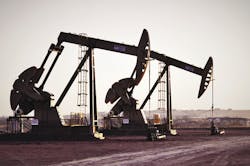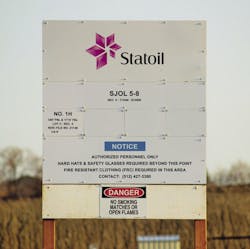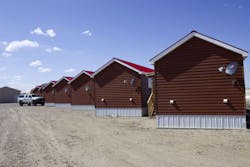MDU expands North Dakota presence with greenfield refinery
Rachael Seeley, Editor
STARK COUNTY, ND—A greenfield refinery, an interstate gas pipeline, and production from the Bakken shale are just a few of the projects being pursued by MDU Resources Group Inc. in the rolling prairie of North Dakota.
MDU Resources is involved in many aspects of the energy business in the Peace Garden State. Its biggest project currently is the Dakota Prairie Refinery, a $350 million topping plant slated to come online near Dickinson, ND, later this year. The facility will be the second refinery in North Dakota.
The 20,000 b/d refinery will be capable of producing 7,000 b/d of diesel, helping to satisfy a growing demand in North Dakota underpinned by development of the Bakken shale.
"It's really a simple matter of supply and demand," John Stumpf, senior vice-president of business development for MDU subsidiary WBI Energy, said of the decision to build the refinery. Western North Dakota is not served by a products pipeline, most diesel is trucked or railed in from out of state. North Dakota currently has just one, 60,000 b/d refinery near Bismarck, 100 pioneer in the play. Statoil now holds about 330,000 net acres in the Bakken, producing roughly 50,000 boe/d. This year, six rigs and two hydraulic fracturing crews are expected to drill about 100 operated wells.
The CNG pilot program currently supplies CNG to one of these rigs and two frac pumps.
Statoil 2 years ago converted all of its Bakken rigs to run on bifuel technology. The company initially sought to displace 40-50% of diesel usage across its rig fleet using onsite gas, but the early program was shown to be unsustainable. Langford said, "We were trying to take wellhead gas to wellsites but figured out that program was unsustainable because: One, you don't always have available gas right next to where your rig is and then physically you've got to run it [by pipeline] across the surface."
Verifying potential
Statoil is looking to advance its CNG pilot program. "We're in the process of looking at a more full-scale confirmation. We know we can process it, we know we can burn it, we know we can reduce costs at the rig with the cheaper gas, and we know we can reduce emissions because we've stripped all of those heavies out," Langford said.
One barrier to expanding Statoil's program is the lack of an established market for gas in the form of CNG in North Dakota. "To make the economics work you've got to have a market for all of your gas. What you don't want to have is to spend all of this money on this equipment and then only have 50% utilization," Langford said.
Numerous untapped markets for gas transported as CNG exist in North Dakota. Besides powering equipment like rigs, fracing equipment, and workover units for the oil and gas industry, CNG also has potential applications in agriculture, where the gas can be used for grain drying, fertilizer, and asphalt production.
Langford said Statoil could compress all of its associated Bakken gas now, but it would ultimately end up with far more of the fuel than it could utilize. The key to making the program work is developing a market for gas transported as CNG in North Dakota, something that Statoil hope state leaders will step in and help make a reality.
Speaking to an April hearing on the flaring issue held by the North Dakota Industrial Commission, Langford said, "I really believe CNG is going to make an impact, [but] it's not a catch-all solution."
Reaching out
Flaring is not the only unintended consequence of Bakken development. Rural communities are also challenged to provide services—like housing, law enforcement, water, sewage, and recreational activities—needed to support the influx of workers that accompanied the oil boom.
One of the new arrivals to the community was Russell Rankin, regional director for Statoil. Rankin moved his family to Williston from Austin, Tex., in 2010 to oversee what was then Brigham's growing Bakken shale operations.
A number of projects were under way at the time. In addition to drilling and completing wells, Brigham was constructing a regional office in Williston and overseeing the installation of pipelines and midstream facilities.
Since his arrival in 2010, Rankin has watched the population of Williston grow from 12,000 to nearly 30,000. City infrastructure is now catching up with development. Numerous hotels and restaurants have been constructed, new oil and water pipelines are reducing truck traffic, and the city recently completed a $70 million recreation center.
To address the housing needs of Statoil employees and contractors, the company has erected a 14-cabin crew camp adjacent to its regional headquarters in Williston. On any given day, more than a dozen trucks can be seen parked outside. Across the highway is a large, dormitory-style housing facility for workers operated by Target Logistics. Many Bakken workers maintain permanent residency out of state, likely due to the limited availability and high price of local housing.
Statoil helped form Energy Outreach Williston, which has supported Meals on Wheels, youth after-school programs, local parks, city-wide cleanups, and renovation of the town's high school auditorium. Group members include executives and managers from Oasis Petroleum, Nabors, Baker Hughes, Halliburton, and Schlumberger.
"Before, people didn't know who to go to," Rankin said. "Now they can come to one organization and say 'Can we get some help with this?'"
Ultimately, Statoil lets simple principles guide its efforts to reduce Bakken flaring and engage local communities in the Bakken. According to Langford, "It's about doing the right thing and sustainability."



